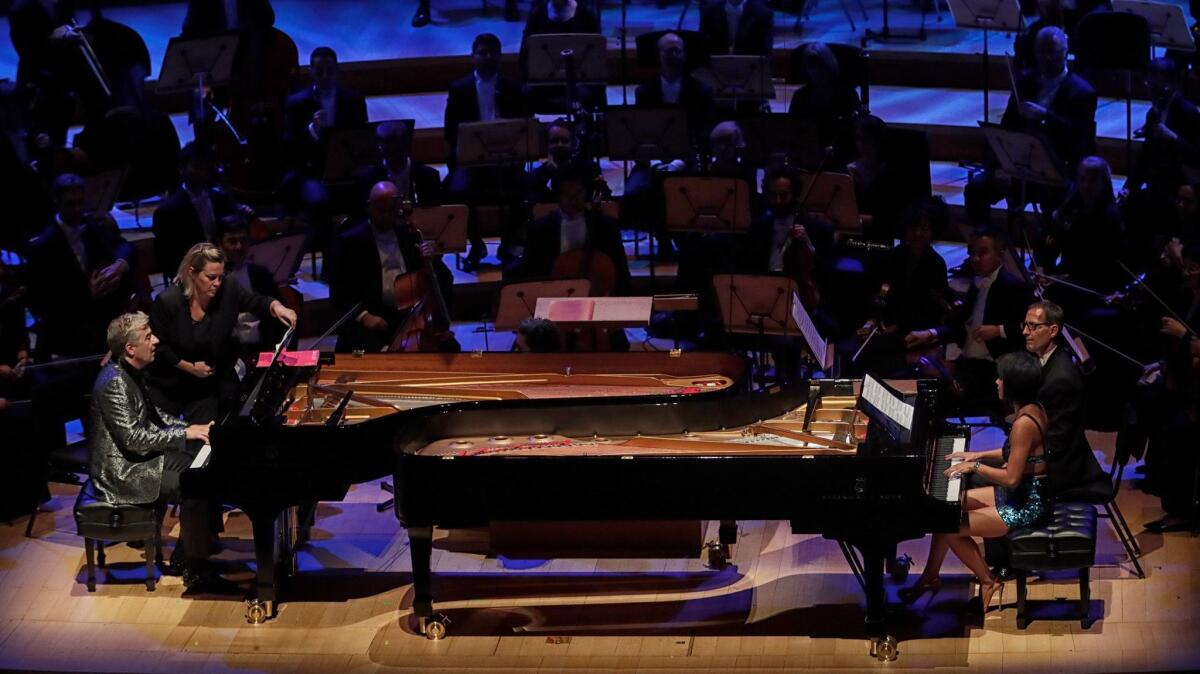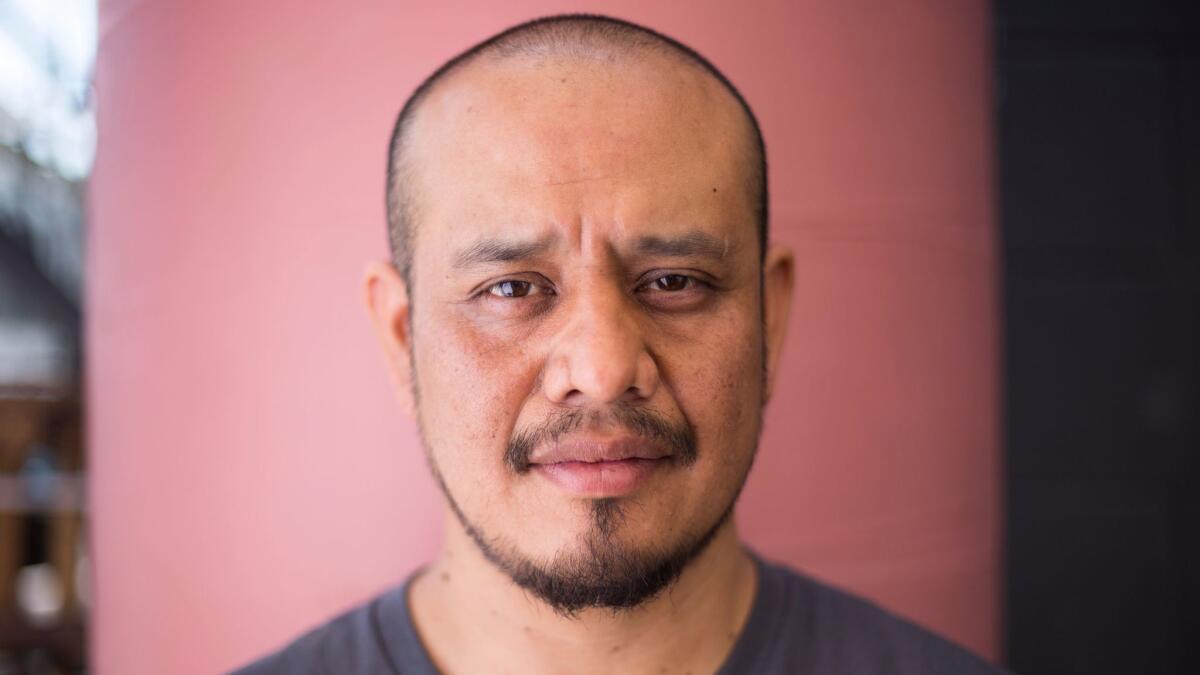Newsletter: Essential Arts & Culture: Rage and grief at the Taper, art of color and movement, Obama’s library
A play about secrets and grief in Los Angeles. Light and color in Palm Springs. Constructing Obama’s presidential center in Chicago. I’m Carolina A. Miranda, staff writer for the Los Angeles Times, with your weekly dose of all that’s hot and not in the world of culture:
A MOTHER’S SECRET
Tarell Alvin McCraney, who became the Yale School of Drama’s playwriting chair in July, shared the adapted screenplay Oscar with director Barry Jenkins for “Moonlight,” this year’s best picture winner. Now McCraney’s latest stage work, “Head of Passes,” has landed at the Mark Taper Forum. It is the story of a Louisiana mother, played by Phylicia Rashad, who wants to bring her fractious brood together at the end of her life. The plot, writes Times theater critic Charles McNulty has its weaknesses, but Rashad “makes you forget all about that by tapping into a raw vein of grief and rage.” Los Angeles Times

Times reporter Tre’vell Anderson sat down for an interview with McCraney. “On the theater side, I say that I’m interested in when theater was both religious and community-necessary,” he says. “This goes way past what we think of as the great Broadway era to every cosmology’s natural origin, every campfire, every shogun tent and coliseum.” Los Angeles Times
ART OF LIGHT AND MOVEMENT
An exhibition at the Palm Springs Art Museum looks at the mind-boggling work created by South American kinetic artists in the 20th century. The show, part of Pacific Standard Time: LA/LA, adds valuable scholarship and offers some tantalizing experiences of movement, color and light. An installation by Venezuelan artist Carlos Cruz-Diez, writes Times art critic Christopher Knight, with its “spatial zones of transparent violet, orange and other rainbow hues surprise expectations and complicate internalized perceptions.” Duuuuude. Los Angeles Times
Plus, since we’re on the subject of PST: LA/LA, the Times’ Deborah Vankin has a report on the Cuban posters that serve as love letters to U.S. cinema — on view at the Pasadena Museum of California Art. Los Angeles Times
BUILDING OBAMA’S PRESIDENTIAL CENTER
The Obama Foundation held a public event in Chicago to discuss plans for the Obama Presidential Center designed by Tod Williams and Billie Tsien. The meeting brought together foundation officers and local activists who want the foundation to guarantee jobs to locals. Times architecture critic Christopher Hawthorne was there — and he reports that the event, like many things Obama, was carefully stage managed. And not necessarily for the best. Los Angeles Times

Sort of related: The Obama Foundation has just launched a fellowship that includes a call for applications from artists. Artnet
THE L.A. PHIL’S MOZART GALA
Most orchestral galas, reports Times classical music critic Mark Swed, tend to be quick and flashy. But not the Los Angeles Philharmonic’s season opener, which featured early compositions by Mozart — with the participation of star performers such as Austrian soprano Anna Prohaska and Jean-Yves Thibaudet and Yuja Wang on piano. “The orchestra,” he writes, “remarkably refused to underestimate its classy crowd.” Los Angeles Times

Plus: The Los Angeles Master Chorale kicked off the Leonard Bernstein centennial with the composer’s “Chichester Psalms.” Los Angeles Times
VOICE OF L.A.
The Times’ Jeffrey Fleishman has been doing a series on artists whose work is rooted in Los Angeles. And this week he has a beautiful profile of poet Robin Coste Lewis, L.A.’s poet laureate. “I do think L.A. is just as intellectually rigorous as any other place, but that’s not the stereotype of it, because of the dominant influence of Hollywood,” she tells him. “The beaches. The palm trees. The manufactured identity we’ve put into the world is unfortunate because there’s so many brilliant histories that are taking place here all the time.” Los Angeles Times
THE GUGENHEIM’S CONTROVERSIAL DOG SHOW
The Guggenheim Museum has pulled three controversial works from an exhibition on Chinese art after drawing protests. These included a video of dogs chained to non-motorized treadmills attempting to fight each other. Animal rights activists praised the decision. But some are worried that it sets a bad precedent of museums removing uncomfortable art to satisfy public opinion. “When an art institution cannot exercise its right for freedom of speech, that is tragic for a modern society,” Ai Weiwei said in response. New York Times
In an interview given before the uproar, the show’s curator Alexandra Munroe, said the show was intended to be difficult: “It’s gritty and tough and brutal because that is the world these artists have lived in.” Artnet
Critic Ben Davis has an absolutely essential essay on the show’s context: within art and within Chinese history. And he picks apart the ways in which the Guggenheim failed to adequately convey the work’s place and time. Must read. Artnet
DACA AND THEATER
The Trump administration’s decision to phase out the Deferred Action for Childhood Arrivals Program (DACA) has put a spotlight on “Wet: A DACAmented Journey,” a one-man play by Alex Alpharaoh. In it, Alpharaoh tells the harrowing tale of how he came to reside in the U.S. Recent audience members have included U.S. Congress member Adam Schiff. “I don’t consider myself an activist,” Alpharaoh tells the Times’ Jessica Gelt. “I’m an artist and I’m sharing my testimony because this is what I do.” Los Angeles Times

CELLPHONE AS STAGE STAR?
Kevin Armento’s “Please Excuse My Dear Aunt Sally” at the Odyssey Theatre features a cellphone as protagonist. The sentient cellphone, played by Thomas Piper, belongs to a 15-year-old boy, who has it confiscated by his teacher. The center of this production, which toys with moral and theatrical conventions, is Piper, writes Charles McNulty, as an “invigorating incarnation of an eager-to-please phone.” Los Angeles Times
TOO MUCH TALKBACK IN THE THEATER?
Many works of theater now feature talkback sessions between audience and cast. Some directors loath them. (David Mamet has famously banned them.) Others say they serve a critical purpose. Times contributor Stuart Miller dives in. Los Angeles Times
AROUND L.A. THEATERS
Writer Paul Rudnick, whose play “Big Night” is at the Kirk Douglas Theatre, sat down for a chat with Times contributor Margaret Gray about comedy in the age of Trump and why he loves See’s Candies. Los Angeles Times.
Contributing reviewer Philip Brandes reports on A Noise Within’s staging of Jean Giraudoux’s “The Madwoman of Chaillot.” The performance, he writes, “extracts every drop of contemporary relevance from the play’s satirical black gold.” Los Angeles Times
F. Kathleen Foley has a look at Nick Salamone’s “Billy Boy” at the Atwater Village Theatre, a work that features “luminous staging” and “bracing naturalism.” Los Angeles Times
Plus, check out The Times’ weekly guide to what’s happening in L.A.’s 99-seat theaters. Los Angeles Times
IN OTHER NEWS...
— Annie Lenox will perform at the Los Angeles County Museum of Art’s gala, which will honor Mark Bradford and George Lucas. Los Angeles Times
— Prices are going up for Hollywood Bowl tickets and parking. Los Angeles Times
— Gentrification of theater? Alex Needhan on how London’s Punchdrunk company became a luxury brand. The Guardian
— New York’s Metropolitan Opera is offering buyouts to close a deficit gap. New York Times
— The late Gin Wong’s Union 76 gas station in Beverly Hills is moving toward landmark status. Curbed
— The Academy Museum of Motion Pictures (a.k.a. Renzo Piano’s alien space ball) has unveiled design concepts for its exhibition spaces. Architectural Record
— The new Lego House in Denmark, just completed by the Danish architect Bjarke Ingels, is very Lego. The Guardian
— The late Dick Gregory on the importance of Jet magazine. Paris Review
— How Michigan’s ArtPrize became politicized for its connections to education secretary Betsy DeVos. New York Times
— The rise of the Instagram-friendly art installation (featuring on-fire quotes from The Times’ Christopher Knight). Wired
— Transporting bags of cash and other alleged irregularities surrounding Documenta. Artnet
— Mexican artists are pitching in to help victims of the quake. The Art Newspaper
— Puerto Rican art institutions shut down in the wake of Hurricane Maria. Artforum
— What’s it like to be an artist from Boyle Heights? This 10-minute doc, which follows artist Guadalupe Rosales, who grew up in the neighborhood, offers a very worthwhile look. Hyperallergic
AND LAST BUT NOT LEAST...
Zodiac signs ranked by how long they’d survive in a horror movie. Thought Catalog
More to Read
The biggest entertainment stories
Get our big stories about Hollywood, film, television, music, arts, culture and more right in your inbox as soon as they publish.
You may occasionally receive promotional content from the Los Angeles Times.











